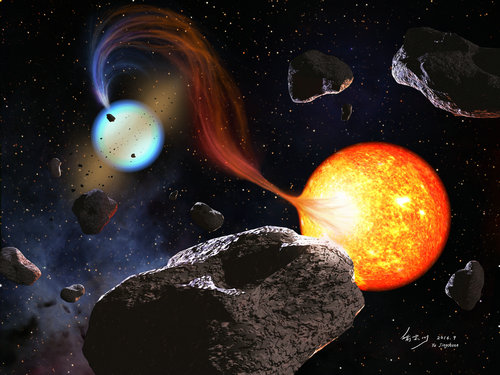About a half of the stars in our Milky Way are in binary systems. Some of them are close binaries, in which two stars can gravitationally distort their mutual outer stellar atmospheres. If one component of the binary evolves into a white dwarf (WD) stage and its close companion overflows its Roche lobe, the WD will accrete mass from the companion’s outer atmosphere.When a WD forms, sometimes, a very strong magnetic field is uncovered on its surface, and the material will flow along the magnetic field lines without forming an accretion diskuntil it violently accretes in a shock near one or more of the magnetic poles. This kind of binary stars is called polars due to the strong optical-infrared polarization.
AR UMa is inferred to contain a WD that possesses a magnetic field of ∼240 MG—the strongest of the known polars. Dr. Yu Bai, Prof. Stephen Justham and other co-authors from the National Astronomical Observatories of Chinese Academy of Science have carried out an observational campaign on AR UMa with the 5m telescope at the Palomar observatory. Its time-resolved spectra display a clear Al I absorption doublet, alongside spectra taken less than a year earlier in which that feature is not present. Re-examination ofearlier SDSS spectra indicates that the Al I absorption doublet was also present ≈8 years before the first non-detection.
Such Al I absorption lineis unlikely of telluric origin or an artifact of the telescope system, nor is it from the foreground interstellar medium, since the dispersion is about 300 km s−1. Moreover, the profile of the Al I doublet strongly argues against the absorption feature being from the surface of thehighly magnetic WD in AR UMa. All the spectral features from the atmosphere of the WD should be split into wide ranges of wavelength and be barely recognizable of AR UMa.
It is suggested that this Al I absorption feature arises in circumstellar material, and a tentative potential explanation for the origin of this circumstellar gas is that AR UMa possesses an extra-solar analog to the Oort cloud or the Kuiper Belt, containing some Al-rich rocks. The orbits of thoserocks might become destabilized due to perturbation of the binary motion or dynamical interaction with other planets in thesystem, after which they approach so close to the WD as to be evaporated, resulting in circumstellar gas in the form of a highly eccentric ringor spherical cloud around the WD.


Address: 20A Datun Road, Chaoyang District, Beijing, China code: 100012
Tel: 010-64888708 E-mail: naoc@nao.cas.cn

